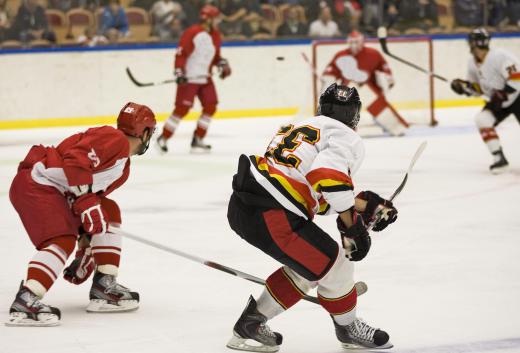Icing is a rule in hockey that is designed to prevent a team from sending the puck deep into its opponent's zone — also called "dumping" the puck — in order to run time off the clock or to avoid playing defense. Except in certain instances, a team is guilty of this when a player on his or her team's side of the center line sends the puck all the way past the opponent's goal line without the puck touching another player or going into the net. This is considered a delaying tactic that interrupts the flow of the game. After icing is called, a faceoff is held in the defensive zone of the team that iced the puck.
Hockey Rink Lines

On a hockey rink, there are red and blue lines that extend horizontally across the width of the ice to mark certain areas of the rink. The line at the center of the rink is red. There is one blue line on each side of the center line, typically 25 to 30 feet (15.2 to 18.3 m) from the center line, depending on the specific rules being used. About 10 to 15 feet (3.0 to 4.6 m) from each end of the rink is the goal line, which is red, and at the center of which is the front of the net.

A common way of referring to an icing infraction is when the puck crosses at least "two red lines" without being touched, with the final red line that it crosses being the opponent's goal line. In other words, the puck must pass the center line and the opponent's goal line for this infraction to be called. If the puck crosses the team's own goal line and the center line, the puck has crossed two red lines, but it has not crossed the opponent's goal line, so no icing would be called.
Rule Variations

Different leagues and organizations have slightly different applications of this rule. In the National Hockey League (NHL), the major professional league in North America, it is not called until the puck crosses the goal line and an opposing player other than the goaltender touches the puck with his stick. In international play and in most European leagues, there is what is called "no-touch" icing, in which the infraction is called and play is stopped as soon as the puck crosses the goal line, regardless of whether an opponent touches it.
Exceptions
There are certain instances in which icing will not be called, or will be "waved off" by the referees. This is most common when a team is shorthanded — which occurs when it has more players in the penalty box than its opponent. If the opposing team has more players on the ice — which is called being on a power play — the shorthanded team is allowed to dump the puck at any time from any point on the ice.
During even-strength play, when both teams have the same number of players on the ice, icing can be waved off if the referee determines that an opposing player could have touched the puck before it crossed the goal line or that the infraction was the result of a pass that was missed but could have been reasonably completed. These exceptions prevent the defensive team from earning an easy faceoff near the opponent's goal, and they prevent the offensive team from being severely penalized for an errant pass. The intent is to limit the infraction to instances in which a player clearly dumped the puck deep into the opponent's zone without clear offensive intentions.
NHL Rule Modification
The icing rule generally is successful at preventing teams from running down the clock by dumping the puck. In the early 21st century, NHL officials felt that a team that was stuck in its own defensive end for a long period of time would often ice the puck just to be able to get fresh players on the ice when the game was stopped for the ensuing faceoff. In 2005, the NHL modified the rule to state that the five players on the ice for the offending team must remain on the ice for the faceoff. This modification helped reduce the number of icing penalties by making those penalties stiffer. It also helped to speed up the game by reducing these calls and reducing the line changes made between a call and the subsequent faceoff.
